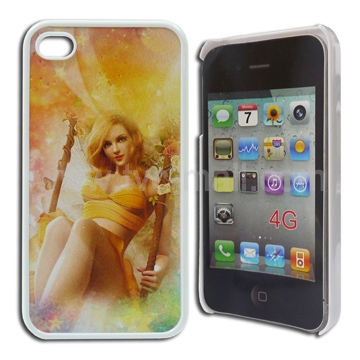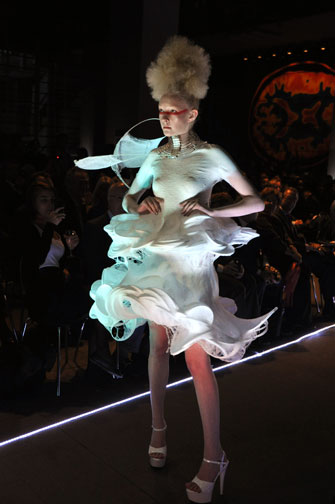Is Technology the Future of the Fashion Industry?

The scientific development of machinery, such as the cloth cutters shown above, was borne from the rudiments of the industrial revolution. Later, chemical experimentation and production of synthetic fibres and threads by companies such as Dupont, provided technological tools which could be applied to the older hand-making sewing crafts of yesterday to produce fashion garments of today. Tools, such as computers and electronic software, have created a virtual trampoline, allowing fashion designers such as Miyake to bounce his embryonic artistic and sculptural concepts of space, form and silhouette, off collaborators such as graphic designers, manufacturers and producers. The continuing scientific experimentation and development of fabric technology within today’s expansive global fashion industry allows clothes to communicate with an ever-evolving galaxy of e- consumers.

From cut, sew and pattern cutting techniques using sewing machines, protractors and thread, today’s designers are able to use ultrasonic welding and “three-dimensional knitting machines” such as those designed by Shima-Seiki. The technique of producing clothes with no seams was perfected by Issey Miyake and further developed by Hamish Morrow in 2004, who produced a “stitchless, seamless, welded and moulded dress in polyester jersey” which draped the body. The words “technology” and “fashion” are synonymous with Miyake’s innovative fame. One of his major innovations that changed the world of fashion design and production was A-POC (a piece of cloth), which produced a “tube of fabric” after “a single thread entered a computerized machine and a finished, customisable, garment came out the other end”.

Subcultures
The rapid advancement and speed of digital technology, social networking and online retail sales means fashion, and associated accessories, are now as close as your iphone is away, and that is usually in your hand or pocket for the youth culture of today. Choosing to wear specific fashion items and accessories is a way of defining individuality, providing security and a sense of sharing and expressing gender and sexual preferences within sub-groups of society. Such fashions may be spear-headed by specific designers who become a focus definer within that sub-culture.

One such example, are the Punks of London who, in the late 1960s, were the rebellious “public voice for truth, freedom and marginalised youth”. Teacher, Vivienne Westwood, along with husband Malcolm McLaren, produced a small revolutionary range of clothing, including new black latex rubber tights and cut-out anarchy T-shirts from a simple little sewing machine in their upstairs bedroom. Today, Westwood runs a fashion empire using modern technology, such as Wolfords’ exclusive knitting machines, and sustainable rubber for shoes, in her continuing evolutionary search to re-invent fashion from its historic roots.

Wolford, an Austrian company, “fuses modern technology with femininity” to produce luxury and glamorous lingerie which remain durable due to “production techniques adapted to work with the knowledge of luxury fabrics in cut and style”. Working with major fashion designers such as Armani Wolford has its own sub-culture of women who want to be identified with the “leading global innovator of hosiery and lingerie”, even producing a range of Polar Tights which are said to be “soft and stylish” and keep you warm in – 45 degrees because of their “isothermal effect”.

The Fabrication of Yesterday
The latter half of the 20th century saw enormous cultural and socio-economic changes throughout the world with a freedom of expression allowing women to become better educated and financially secure following World War II. With this new-found freedom, there was a move away from an encumbered domestic lifestyle for women and a noticeable change in the way women dressed and proudly showed off the curves of their bodies for everybody to see.
In the 1960s designers such as French Pierre Cardin and Spanish Paco Rabanne advocated “the modernisation of couture”. Cardin’s “Cardines” were pre-formed dresses with a decorative three-dimensional surface pattern made from his patented Cardine fabric, a synthetic cloth, Dynel, manufactured by Union Carbide”. Current designers with knowledge about environmental standards of “recycling and sustainability” would probably not use this moulded material.

In 1968 Rabanne used various materials such as “metal, paper and plastic” in his designs and this image shows the way technology has changed the whole style of “showing new fashions”. Then, small groups of women clustered round stationary models compared to today’s fast, electronic and media catwalk extravaganzas. Rabanne’s following sexational range saw the production of “moulded” garments that required “no stitching or seaming” and followed a collaboration with Louis Giffard, “a synthetic products manufacturer. The “Giffo” garments were made by spraying “a cloud of plastic into a mould” and produced garments very quickly and very cheaply.

Designers such as Azzedine Alai, known as the “King of Cling” in the 1980s, used new figure-hugging synthetic fabrics, such as acetate and elasticine polymers, to design glamorous dresses which were comfortable, sensual, sexy and easy to launder. Celebrities, often from black Afro-American backgrounds, such as Gladys Knight, Tina Turner and Naomi Campbell acted as role models by proudly wearing such daring skin-tight “cut out” dresses, showing the “average” woman that she too could be proud of her feminine shape.

The Fabrication of Today
In the 21st century governments, specialised groups sharing similar interests, and individuals, are aware of changes related to the damaging effects of climate and the benefits of a healthy lifestyle. The growth of these health and sporting industries has led to garments being designed, usually with environmental and ethnic awareness, for such consumers of fitness and adventure. Scientific research into fabrics provide elasticity and stretch for flexibility and movement for gym work and cycling. Other fabrics protect, retain heat, absorb moisture and allow for the circulation of air, yet still maintain comfort, for sports such as skiing and surfing, are manufactured by well known international fashionable outdoor brands such as Colorado and North Face.


Experimentation in the 1970s began with electronic “smart clothing” or “wearables” which enabled the “processing of information on the moving body”. Steve Mann was a pioneer of this technology which was basically a military and male transformation of desktop applications being “worn and operated on the body”. Such “hardware” is often worn in pockets and attached to vests and jackets, but such technology did not transcend into fashion due to “lack of comfort, washability and user-friendliness”.


The Fabrication of Tomorrow
Recent developments have led to the miniaturisation of digital components such as “MP3 players, digital cameras and laptops”. Computer scientists such as Mark Weiser and electronic companies such as Philips are continuing to research “xybernaut” wearables, following designer Gilbert Rohde’s prophesies in American Vogue’s February 1939 issue that “men of the next century would be wearing an air-conditioned zippered Solosuit with antenna that snatches radio and Omega waves out of the ether”.

E-textiles are “fibres, yarns, fabrics and ribbons that conduct electricity” and as fabrics, can “sense when and how they are being touched”. Fashion techniques used in the weaving and knitting of such materials can therefore create “conductive fabrics” using coal and metals such as gold and silver. The interpretation of such technology could lead to “gold embroidery becoming a switch or radio transmitter or a handknit cardigan sensing poor posture”. French Telecom have since designed a communicating-multimedia scarf that allows the wearer to “connect to the internet, send emails and watch a film”. The latter was produced between the collaboration of “hybrid-design company Electronic Shadow” and fashion designer “Christophe Beaufays”. It is described in fashion terms as “a sober and elegant accessory and also a communication tool whose configuration of the virtual environment develops along with our activities”.

PAN, personal area network, is an idea that was thought up by researchers Zimmerman and Gershenfeld and links the “electrical conductivity of the body to send data to other people or devices” through the aid of small computers concealed in shoes or gloves. This seemingly absurd idea was patented by Microsoft in 2004 who believed in “the human body being a computer network”. The embedding of such electronics into clothing or using fabric as an interface for communication is likely to become the “fashion” of health workers who, after receiving data, can remotely control and remedy implanted devices such as pacemakers. It is an interesting thought to consider if the “forced” wearing of clothing by health professions has led to the formation of a sub-culture of society that provides friendship, security, language and beliefs in the same way as the sub-cultures described above. The images of medical sub-cultures below show “Medical Punk “ and “Medical Fashion” both distinct fashions, but not comparable to the more conservative dress of white-coated doctors, nurses and theatre staff who usually wear clothes applicable to safety, uniformity and health standards.


Wiring and electrical circuitry in fabrics follows further research into communication and issues regarding identity and whether electronics can actually become part of the fabric itself. For the wearer the fabric must be comfortable and functional and washable. Whether future advances allow clothing to be a “conduit to a phone or laptop”, means research must take into account if clothing can be “hacked” or if our “wired” bag is stolen does that mean we lose our personal identity?

Other fabrics under research are those connected with “nature” which are becoming more commercially viable and eco-friendly with the aid of biotechnology. Presently a fibre is being investigated to replicate the “toughness, lightness and stretch” of spider-thread silk into a cloth that is breathable and gossamer-thin for use in leisure and sports wear. It has been suggested that biodegradable and recyclable fabrics can be “grown in a bioreactor” which encourages bacteria to “multiply rapidly and produce cellulose”, thus “growing clothes” within hours.
Cloth that glows can now be made by introducing “bioluminescent” bacteria into fibres which are then woven into fabrics. “Light” in fashion has been used, especially in jewellery from Monsieur Trouve from the late 1880s, but designers now experiment with new technologies such as batteries, LEDs and fibre optics in their exploration of “exploring the body and space”, such as Atsuko Tanaka’s “electric dress” of 1956.

Mutable clothing means that fabrics, usually made from materials with electro-active polymers allow clothes to change shape, and in this process protect and change body shapes, according to changes in light and temperature and mood. Presently such fabrics do not lend themselves to comfort, washability or affordability – specific properties related to “dress” but not necessarily the more flippant features of “fashion”.
The use of Computer-aided Design software and 3D print technology presents a new “functional and aesthetic” way for designers to look at sculpturing fabrics, allowing for variations in depth and density of garment to transform from “soft, fluid, organic forms” to “tougher rigid spikes”. Philip Delamore in the UK continues to research the practical possibilities of producing such garments but further technology is needed in the form of hardware machines, and research into integrating stretch and elasticine into nature fibres that can be sustainable and recyclable.
It is impossible when talking about fabrics of tomorrow not to dismiss the advances of nanotechnology. Such fabrics have special textile finishes that “look and feel” like others but “repel stains, resist wrinkles and fight bacteria”. Scientists have shown that sensors such as light, pressure, moisture and stress, and motors, can be included in these fabrics which require less washing and “launder at lower temperatures”, and are thus environmentally friendly, communicative, and adaptive to human wearing. In 1998 Miyake used molecular technology, the “starburst” technique of “heat pressing” natural fabrics with a membrane of metallic foil, in his “Making Things” exhibition to present clothes which seemed to “emerge like a butterfly from a chrysalis.”

And of course there’s fashion designer Manel Torres who developed and patented FabriCan. This colourful spray-on-fabric consists of “fibres mixed with a binder” and the fibres can be built up and layered or have special effects of “glitter or perfume” added.

Conclusion
So where does this discussion leave tomorrow’s wearer, and who in fact is tomorrow’s wearer of fashion technology?
Perhaps fashion devotees will live in their own virtual wardrobe, programming themselves and having their computer mix and match their uploaded selections each morning. Or use the mini virtual wardrobe iphone app for a quick change into “cocktail clothes” for evening attire?

Fashion theorist Laver, believes there is a certain predictability about fashion that historically relates to its repetitive nature and he describes this as a “trend”. In keeping with Laver’s Law and the forecast of tomorrow’s trend, I think it will be knitted Beatnik black leggings, made from magnetic elasticine, that are GPS wired to map out the direction of the wearer’s daily activities, according to changes in the weather.
As Delamore says: “We’ve still got this problem of what people want to wear and why they want to wear it. I don’t think engineers and chemists consider these things when it comes to commercialization. This is why so much technology ends up as a gimmick for a very short time instead of gradually seeping into the fabric of our lives”.

All images courtesy of Google images


























